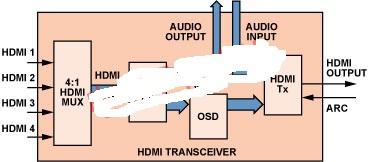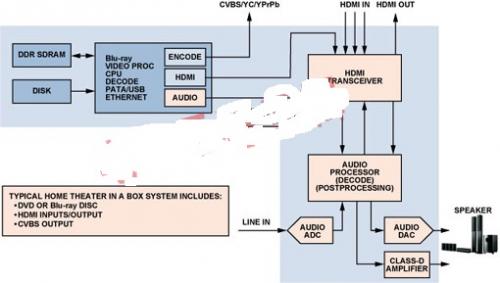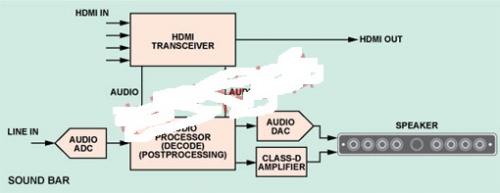Simplify Home Theater System Design Using HDMI Transceivers
Time:2023-03-30
Views:1028
Brief introduction
Today, large screen HDTV (High Definition Television) has been widely recognized by consumers, and people are purchasing various electronic devices to improve their home theater systems. Standalone home theater (HTiB), SOUNDBAR speakers, and audio and video receivers (AVR) can provide users with a better audio experience and improve HDTV video performance. The ability to extract and process high fidelity audio signals is a key factor in selecting hardware on the current market. Home theater systems are now able to provide all the latest features of High Definition Multimedia Interface (HDMI) (seamless integration with devices).
For system designers of HTiB, SOUNDBAR speakers, and AVR, improving the user experience of home theaters means constantly overcoming various implementation challenges. New features have been added to the latest HDMI standard, such as Audio Return Channel (ARC), 3D display format, and improvements to the Consumer Electronics Control (CEC) protocol. Of course, consumers hope that their newly purchased home theater device will have all these new HDMI features, and be inexpensive and easy to operate. Therefore, designers of home theater equipment must adapt to new standards while reducing material costs, development costs, and time to market. To help designers meet these challenges, ADI has launched HDMI transceiver products that integrate these new features.
Taking the ADV7623 as an example, this HDMI transceiver integrates a 4:1 HDMI input multiplexer (mux), an HDMI receiver, an on-screen display (OSD) engine, and an HDMI transmitter. Individually, each of the above functions should require independent ICs and a variety of firmware. However, a single transceiver can combine all functions into a comprehensive solution, saving on-board area, reducing firmware complexity, and reducing material costs, bringing great convenience to home theater system designers.

Figure 1. Functional block diagram of HDMI transceiver
Single Home Theater
HTiB is a complete video playback system that typically uses multi-channel audio amplifiers and surround sound systems to play audio. In addition, the system typically includes a DVD or Blu-ray video player. HTiB simplifies the installation and power matching of video players, amplifiers, and speakers. It mainly processes audio, while video is transmitted to televisions through an HDMI interface. Figure 2 shows a typical HTiB system.
 .
.

 .
.Figure 2. Typical HTiB System Block Diagram
SOUNDBAR speaker
With the increasing popularity of ultra-thin and large screen flat screen televisions, the emerging SOUNDBAR speaker has become a complementary audio and video system. This sound system has a compact structure, convenient installation, and far higher sound quality than television speakers. Most HTiB and SOUNDBAR speakers are used with large screen HDTV, so their audio and video connections mainly use HDMI interfaces. SOUNDBAR speakers typically have multiple HDMI inputs for various signal sources, one HDMI output for connecting to a TV, and a built-in audio processing system and speakers. Figure 3 shows a typical SOUNDBAR speaker system.

Figure 3. Block diagram of a typical SOUNDBAR speaker with an HDMI hub
The advanced SOUNDBAR speaker box is equipped with multiple speakers and amplifiers, and has surround sound decoding capabilities. Its electronic and acoustic design features can produce surround sound effects without the need to install separate speakers in the rear. The high-end SOUNDBAR speaker system includes DVD or Blu-ray players, forming a system architecture similar to HTiB. Audio Return Channel (ARC)
As a new feature in the HDMI specification, Audio Return Channel (ARC) allows HTiB to process audio from downstream devices. If you want to listen to TV audio without ARC, you need a separate cable (S/PDIF fiber or coaxial cable) to send the audio from the TV or tuner back to HTiB. With ARC, HDMI cables can transmit 2-channel S/PDIF or multi-channel audio from the TV back to HTiB without using additional audio cables. The HDMI transceiver provides an ARC receiver on the HDMI output port.
ARC is significant when televisions, set-top boxes, or other downstream HDMI receivers use tuners to receive new media content. If users no longer want to listen to the sound of ordinary TV speakers, they can easily use the high fidelity HTiB system output. The returned audio data is transmitted from the TV to the HTiB through an HDMI cable (in the opposite direction to the traditional video data path), so there is no need to worry about whether the video output to the HTiB is in a valid state on the cable.
Extended Display Identification Data (EDID) Replication
HDMI transceivers have an EDID replication feature that allows multiple HDMI ports to share a location memory (even if HTiB is in power saving mode). This feature can shorten system startup time because all upstream HDMI source devices can properly configure their video output before HTiB is powered on. The EDID replication function requires only a+5 V/55 mA power supply and is provided through an HDMI cable.
3D Video
As a bridge between 3D content sources such as game consoles, Blu-ray players, and 3D televisions, HTiB manufacturers must always be at the forefront of technology, constantly designing source and receiver devices that can provide new features, allowing customers to enjoy the long-term benefits of all features. HDMI transceivers use the latest HDMI technology to add a 3D video experience to home theater systems. This new feature of the HDMI standard has significantly improved the user experience and become the key to stimulating TV sales.
This specification defines the infrastructure for home playback of 3D video, supporting a range of mandatory and optional video formats. In practical applications, HTiB must submit a list of supported 3D formats to the connection source - read from the connected TV and analyze its own 3D format support list. Then, the connection source will notify HtiB through HDMI protocol commands when sending 3D content, and HTiB will then extract and output advanced audio formats, such as Dolby TrueHD or DTS-HD Master Audio, which are sent through the HDMI link, Unless the TV may not have support features.
Onscreen display (OSD)
HTiB has many user control functions, such as selecting between multiple inputs, selecting desired audio and video formats, and configuring advanced audio processing options. Users can use Onscreen Display (OSD) functionality to intuitively and easily control these complex features. OSD is typically implemented through dedicated devices, but HDMI transceivers now integrate an OSD engine to integrate the required screen display information into the output video - saving HTiB manufacturers significant external solution costs. In addition, it also saves device costs and material costs, while reducing the design effort of integrating OSD software into the system firmware.
Consumer Electronic Control (CEC) Extension
The consumer electronic control (CEC) channel is a single line communication interface that enables networked operation of home entertainment systems. For example, using a single remote control button can simultaneously switch on and off all devices in the entertainment system. The HDMI standard has been extended to support new features such as ARC and HDMI Ethernet Channel (HEC), and the CEC command library within HDMI transceivers has also been extended to provide support. For HTiB designers, supporting the latest HDMI features requires supporting the latest CEC features at the same time. HDMI transceivers can currently handle the discovery, negotiation, initiation, and termination of ARC and HEC sessions on a single wire network.
Audio insertion and extraction
Another use of HDMI transceivers within HTiB is to extract HDMI audio and process it using digital signal processing (DSP) chips. This allows audio to be re inserted into the HDMI stream and sent to the TV. Because many televisions cannot handle multi-channel audio formats, DSP chips can downsample audio into stereo, and then reinsert the audio into an HDMI link to send it to the television.
Alternatively, the input audio can be completely replaced by a new data stream from an HTiB source and embedded in an HDMI signal for transmission to a TV. In this case, only the audio insertion feature is sufficient. An example of such an application is connecting an iPod to an HtiB and mixing its audio with a separate video stream.
In home theater configurations, the HTiB system can be used as an HDMI repeater, accepting HDMI input and then sending it as an HDMI output. For example, a Blu-ray player can be used as a source device for inputting HTiB. To utilize the HTiB sound quality that is much higher than the TV speaker, it is necessary to extract audio from the HDMI signal within the HTiB. Ideally, audio enthusiasts would like HTiB to be able to output full 8-channel I2S audio, but HDMI links can also provide 2-channel I2S or S/PDIF. Video continues to be transmitted to a TV or display to complete the system path. Only HDMI/HDCP (High Bandwidth Digital Content Protection) repeaters or transceivers can handle this audio extraction.
Firmware/Repeater Support
One of the biggest challenges in HTiB and SOUNDBAR speaker design is implementing HDCP repeater functionality. The repeater function implemented by HTiB is a combination of content protection, EDID management, and audio/video muting. HDMI transceivers integrate the entire repeater process into a single device and firmware, reducing the complexity of system development.
With the increasing complexity of audio and video processing devices, high-quality and reliable hardware abstraction software libraries and application programming interfaces (APIs) have become a major advantage for designers - reducing time to market and starting with a well built HDMI and HDCP compatible platform. If the chip manufacturer‘s shared coding base is adopted from the beginning, further cost savings can be achieved: using the same manufacturer‘s discrete receivers and transmitters in mid to high-end HTiBs can benefit from integrating transceiver coding into mid to low end HTiBs in subsequent upgrades.
Cost saving 2-layer circuit board design
The new HDMI transceivers utilize quad flat package (QFP) technology to provide efficient circuit board layout and routing solutions. Compared to more complex ball grid array (BGA) packages, thin LQFP packages can save manufacturing costs, reduce complexity, and simplify finished product inspection. LQFP greatly simplifies layout issues, and packages can actually be placed on 2-layer boards to achieve low cost while also meeting all necessary HDMI physical layer compatibility test impedance measurements.
The design difficulties of the 2-layer board include: managing the power routing of the transceiver and fully decoupling it; Provide optimal heat conduction; Route the required routing impedances for minimizing transmission differential signal (TMDS) differential pair inputs and outputs. However, by using surface mounted discrete devices, adopting good layout principles, and working closely with printed circuit board (PCB) and chip manufacturers, successful layout with no discount in performance can be achieved with outstanding performance.
conclusion
HDMI transceivers can help system designers reduce the cost and difficulty of designing home theater systems, and provide the latest HDMI features to meet consumers‘ audio-visual experience needs. Using such transceivers can achieve HDMI features such as ARC and 3D video. The integration of an on-screen display (OSD) engine on the HDMI signal path reduces the cost and complexity of HTiB and SOUNDBAR speaker designs. The ability to extract, process, and insert audio within HDMI streams enhances the home theater experience in consumer system design. When HTiB and SOUNDBAR systems are used as HDMI repeaters, the design and firmware of the new transceiver can achieve seamless system docking. HDMI transceiver wiring can be successfully implemented on 2-layer boards, thereby reducing material costs.
Figure 4 shows a typical HDMI transceiver system using ADI company ADV7623, which integrates a 4-way input HDMI receiver (Rx) and an HDMI transmitter (Tx) with audio extraction capabilities. After decoding the HDMI signal, the SHARC audio DSP extracts and processes the audio content. Then, the processed audio is sent to the amplifier and speakers or reinserted into the HDMI signal path. This transceiver also integrates OSD, which can save the cost of separate OSD engines, and is very practical in the design of SOUNDBAR speaker systems. The ADV7623 provides EDID replication, HDCP repeater support, and ARC functionality, supporting mandatory 3D video formats. The ADV7623 is now available in a 144 pin LQFP package for 2-layer PCB design.
|
Disclaimer: This article is transferred from other platforms and does not represent the views and positions of this site. If there is any infringement or objection, please contact us to delete it. thank you! |











